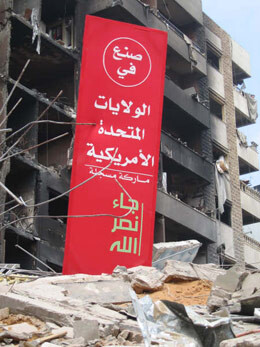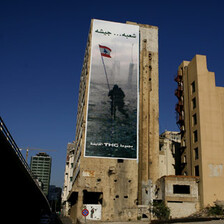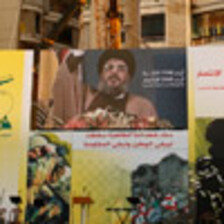Electronic Lebanon 5 October 2007

A sign reads “Made in America” in an area of southern Beirut bombed during Israel’s 2006 attack on Lebanon, August 2006. (Mayssoun Sukarieh)
— Lebanese army head general Michael Sulieman on US support during the summer-long Nahr al-Bared refugee camp battle
Since Israel’s July 2006 war on Lebanon, and up to the current deadlock over electing Lebanon’s next president, the Bush administration has gone out of its way to express its commitment to Lebanese “democracy” and to building a strong and sovereign country that can “stand up” to Syria’s and Iran’s allies within Lebanon’s borders.
Inside those borders, prime minister Fouad Siniora’s March 14 government and the Hizballah-led opposition are sharply split over Washington’s intentions. The March 14 movement has feverishly called on the capital of the “free world” for help and the movement’s civil-war seasoned leaders reassure the Lebanese that the superpower won’t abandon their “cedar revolution.” In response, opposition leaders reiterate their distrust of Israel’s closest ally and accuse its March 14 supporters of holding Lebanon hostage to its enemy’s best friend. In the fog of these accusations and counter-accusations, is it possible to evaluate Washington’s support to Lebanon without resorting to the polemics of either camp?
The true measure of the alliance of any two states or political groups rests on an accurate and fair reading of two forms of support: military aid and economic assistance, and reaching a verdict about these two forms of support is based on the examination of three properties of such aid: the monetary value (size or quantity) of this aid, the declared and hidden objectives of the aid and the conditions attached to it (the quality of the aid). Based on these criteria, what is the truth behind the US support for Lebanon, in numbers and according to Washington’s own sources?
Military Support
One of the main bones of contention between the government and the opposition in Lebanon is the disarming of Hizballah. The March 14 movement does not miss an opportunity to proclaim its intention to build a strong state capable of protecting the country’s borders (particularly the south). And the disarming of Hizballah, the Hariri-led movement claims, is a major step in that direction. So does American military aid provide a realistic alternative to Hizballah’s battle-proven power of deterrence?
From 1946 to June 2006, Lebanon did not receive any significant US military aid except in the years 1981 to 1984. This was the period when the Lebanese army’s official leadership was aligned with forces sympathetic to or allied with Israel, and more importantly it was a period of direct American military intervention in Lebanon. During this period, Lebanon received $148 million in military aid, an average of $37 million per year. This aid surpassed what the country had received in the entire 34 years that preceded; around $128 million (95 percent of this aid was in the form of loans not grants). After 1984 and the partial withdrawal of Israeli troops from Lebanon, US military aid declined to its lowest levels (around half a million annually earmarked for training purposes).
The assassination of former prime minister Rafiq Hariri, contrary to what some might think, did not lead to a fundamental change in this aid policy. The Bush administration’s request was for just one million dollars in 2006 and around $4 million for 2007. The gigantic increase came on the heels of the summer 2006 Israeli war on Lebanon. In the wake of the war, the Bush administration filed an emergency request to congress to provide Lebanon with additional military support valued at $220 million for the single year of 2007.
What we learn from this is that any significant increase in US military aid to Lebanon is temporary and linked to the existence of internal divisions in Lebanon or the outbreak of regional wars or conflicts. And as such, this support is not the product of a strategic alliance akin to that forged between Hizballah and Iran. More importantly though, even when this aid is boosted, the objectives and conditions of its release are far from geared towards building a Lebanese military force capable of defending the sovereignty and territorial integrity of this tiny country.
One wonders about the nature of promises General Sulieman is referring to, but the only binding promises of the US are those stated in the legislative bills tabled by the administration and passed by Congress. And the purpose of budgeting the huge sum of $220 million requested by the Bush administration for this year is very clear in that regard. The State Department has unequivocally declared that the purpose of this aid is to “promote Lebanese control over southern Lebanon and Palestinian refugee camps to prevent them from being used as bases to attack Israel.” (US officials lobbied to spread the fight in Nahr al-Bared to other camps.)
Protecting Lebanon according to the Bush administration is achieved by undermining its ability to fight Israel, the biggest source of threat to Lebanon’s security, and the entity which attempted to invade it in the same year those aid packages were pledged.
Some might argue that America’s above-stated goal is meant to prevent any non-sate organization (Hizballah) from monopolizing the duty of defending Lebanon. But the conditions attached to the aid leaves no doubt that building any force, legitimate or otherwise, is impossible under constraints placed by the US. According to these conditions, any support to Lebanon’s army should be intended for “expanded personal training by private US contractors or provision of spare parts and ammunition for Lebanese forces,” as well as vehicles employed for logistical or patrol purposes. As for equipment and weapons normally used to defend any country’s territory, such as anti-aircraft missiles or tanks or even technologically primitive missiles such as Katyushas, such weapons are out of bounds according to the aid provisions. The administration calls it “non-lethal” assistance. In contrast, permitting Israel to invest a portion of US aid in domestic military research since 1977 was instrumental in the development of the Merkava tank, the primary weapon used for Israel’s land invasion of Lebanon last summer.
Counting on US military aid means transforming the Lebanese army at best to a peacekeeping or patrolling force and at worst an internally oppressive security force. This suggests that the only way to disarm Hizballah without stripping the people of southern Lebanon of the only effective defense force on their land is for the Lebanese government to seek assistance from US adversaries, the same ones possibly Hizballah is allied with.
Economic Aid
The history and present trend of US economic aid to Lebanon mirrors to a great degree that of its military aid. Again, the turning point for an astronomical increase of the aid (much of it remains a pledge) was the 2006 Israeli war on Lebanon and not the assassination of Hariri.
Prior to the 2006 war, American economic aid to Lebanon reached its zenith in the first half of the ’80s (around $53 million in 1983). Between 1986 and 2006, it ranged between $8 and $15 million. The annual aid package then jumped to about $35 million between 2000 and 2006 (the increase was partly an incentive for the Lebanese army to deploy in the south following the withdrawal of Israeli troops in 2000). In the wake of the 2006 war, Washington allocated about $180 million in emergency aid and later requested $300 million in supplemental aid. (Most of this aid was in the form of grants.)
The aid is ostensibly earmarked for post-war reconstruction, declared Washington. But the release of the funds is conditional on the the Siniora government successfully implementing a bundle of economic “reforms.” Indeed, even before Congress approved the aid package, Siniora declared his government’s intention to cut social security programs, privatize the electricity and telecommunications sectors, increase value added tax by two percent, and implement other measures he claimed were aimed to reduce Lebanon’s $40 billion national debt. Siniora’s effort to push through these measures however were met with strong popular resistance inside Lebanon that led him to reconsider the timing and strategy of implementing the “reforms.”
American economic aid to Lebanon was and remains part of neoliberal American policies across the globe that aim to construct an unregulated market-based economy by weakening the economic role of the very governments it purports to support.
US aid: Causes and consequences
How can one explain the US policy towards Lebanon?
First, Lebanon may be a “piece of the sky” according to its famous crooner Wadih Assafi, but in the eyes of US policy makers, it is a bargaining chip used to settle other regional conflicts. In fact, Lebanon does not possess any of the properties that constitute vital national interests to a superpower such as oil fields, international waterways or military bases. Hizballah may be the only serious threat.
In recorded history, only two US presidents described Lebanon using the rhetoric of the “national interest” —(Eisenhower in 1958 and Reagan in 1983). And both references coincided with direct US military intervention in Lebanon and not in the vein of drawing up a strategic vision of Lebanon’s place in foreign policy.
Secondly, The US does not trust two of three types of allies in the Middle East, the Siniora government among them.
The first type is that of political forces or governments that represent elites or particular religious or political communities and who exercise limited authority within countries or territories that suffer from partial or total instability. These countries include Iraq, Palestine, Afghanistan and Lebanon. US military and economic aid to their allies in these countries is mostly symbolic, tactical or directed towards internal security and against the interest of the peoples or these countries.
The second category of allies is composed of governments or dictatorial regimes that represent their own interests over and above that of their people and rule in countries that are partially or totally stable. These countries include Egypt, Jordan, and Saudi Arabia. US aid to this countries is more than symbolic, but often limited and subject to serious constraints.
The last category of US allies in the Middle East is that of governments that speak in the name of the interest of its own people (at least the majority) and rule in internally stable countries. These countries include Turkey and Israel. US aid to these countries makes a significant contribution to the military and economic performance of these countries.
Understanding US aid to Lebanon, and comparing it to similar patterns in Palestine and Iraq in light of this overall map of US aid to the region, leaves little doubt that Lebanese (and by extension Palestinian and Iraqi) politicians betting on the goodwill and unmatched power of Washington to build their country’s defenses, are doing so out of either unintentional or willful ignorance, and both are a recipe for further instability and a disregard for the safety and security of their people.
Hicham Safieddine is a Lebanese Canadian journalist. This is an edited version of an article that appeared recently in Arabic in the Lebanese newspaper Al-Akhbar and is republished with permission.
Related Links





